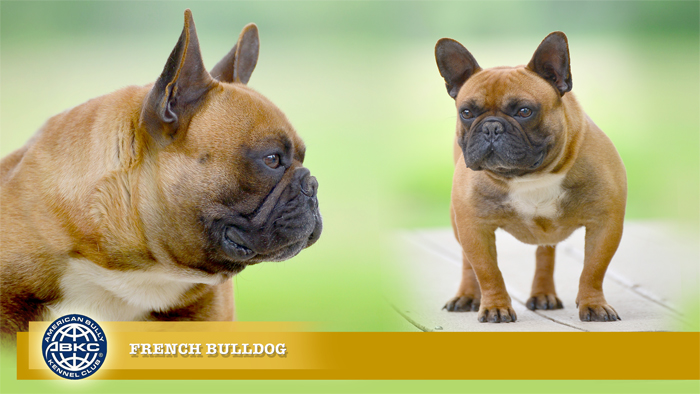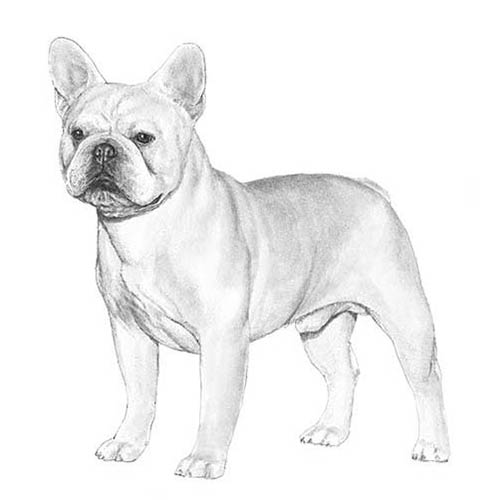Temperment
Adaptable, Playful, Smart
- AKC Breed Popularity: Ranks 2 of 195
- Height: 11-13 inches
- Weight: under 28 pounds
- Life Expectancy: 10-12 years
- Group: Non-Sporting Group
General Appearance
The French Bulldog has the appearance of an active, intelligent, muscular dog of heavy bone, smooth coat, compactly built, and of medium or small structure. Expression alert, curious, and interested. Any alteration other than removal of dewclaws is considered mutilation and is a disqualification. Proportion and Symmetry – All points are well distributed and bear good relation one to the other; no feature being in such prominence from either excess or lack of quality that the animal appears poorly proportioned.

GENERAL APPEARANCE
The French Bulldog has the appearance of an active, intelligent, muscular dog of heavy bone, smooth coat, compactly built, and of medium or small structure. Expression alert, curious, and interested.
PROPORTION AND SYMMETRY
All points are well distributed and bear good relation one to the other; no feature being in such prominence from either excess or lack of quality that the animal appears poorly proportioned.
INFLUENCE OF SEX
In comparing specimens of different sex, due allowance is to be made in favor of bitches, which do not bear the characteristics of the breed to the same marked degree as do the dogs.
SIZE, PROPORTION, SUBSTANCE
Weight not to exceed 30 pounds. Proportion–Distance from withers to ground in good relation to distance from withers to onset of tail, so that animal appears compact, well balanced and in good proportion. Substance–Muscular, heavy bone.
HEAD
Head large and square. Eyes any color, wide apart, set low down in the skull, as far from the ears as possible, round in form, of moderate size, neither sunken nor bulging. No haw and no white of the eye showing when looking forward. Ears Known as the bat ear, broad at the base, elongated, with round top, set high on the head but not too close together, and carried erect with the orifice to the front. The leather of the ear fine and soft. Other than bat ears is a disqualification. The top of the skull flat between the ears; the forehead is not flat but slightly rounded. The muzzle broad, deep and well laid back; the muscles of the cheeks well developed. The stop well defined, causing a hollow groove between the eyes with heavy wrinkles forming a soft roll over the extremely short nose; nostrils broad with a well defined line between them. Nose any color. Flews thick and broad, hanging over the lower jaw at the sides, meeting the underlip in front and covering the teeth, which are not seen when the mouth is closed. The underjaw is deep, square, broad, undershot and well turned up.
NECK, TOPLINE, BODY
The neck is thick and well arched with loose skin at the throat. The back is a roach back with a slight fall close behind the shoulders; strong and short, broad at the shoulders and narrowing at the loins. The body is short and well rounded. The chest is broad, deep, and full; well ribbed with the belly tucked up. The tail is either straight or screwed (but not curly), short, hung low, thick root and fine tip; carried low in repose.
FOREQUARTERS
Forelegs are short, stout, straight, muscular and set wide apart. Dewclaws may be removed. Feet are moderate in size, compact and firmly set. Toes compact, well split up, with high knuckles and short stubby nails.
HINDQUARTERS
Hind legs are strong and muscular, longer than the forelegs, so as to elevate the loins above the shoulders. Hocks well let down. Feet are moderate in size, compact and firmly set. Toes compact, well split up, with high knuckles and short stubby nails; hind feet slightly longer than forefeet.
COAT
Coat is moderately fine, brilliant, short and smooth. Skin is soft and loose, especially at the head and shoulders, forming wrinkles.
COLOR
All colors acceptable. All nose colors acceptable.
GAIT
Correct gait is double tracking with reach and drive; the action is unrestrained, free and vigorous.
TEMPERAMENT
Well behaved, adaptable, and comfortable companions with an affectionate nature and even disposition; generally active, alert, and playful, but not unduly boisterous.
DISQUALIFICATIONS
Other than bat ears.
History
In the mid-1800s, a toy-size Bulldog found favor in some English cities, including Nottingham, then a center for lace making. The toy Bulldog became something of a mascot for Nottingham’s lace makers. This was the height of the Industrial Revolution in England, and such “cottage industries” as lace making were increasingly threatened. Many in the lace trade relocated to northern France, and of course, they brought their toy Bulldogs with them.
The little dogs became popular in the French countryside where lace makers settled. Over a span of decades, the toy Bulldogs were crossed with other breeds, perhaps terriers and Pugs, and, along the way, developed their now-famous bat ears. They were given the name Bouledogue Français.
Paris eventually discovered the delightful new breed, and thus began the Frenchie’s reputation as city dog par excellence. The breed came to be associated with Paris café life, and with the bon vivants and fancy ladies who sought nocturnal pleasures in Parisian dancehalls. Edgar Degas and Toulouse-Lautrec depicted the Frenchie in paintings of the Paris demimonde.
By the end of the 19th century, the Frenchie’s popularity had spread across Europe and to America. The breed was tougher sell in England. The Bulldog was a national symbol, and it rankled many Englishmen that their age-old rivals, the French, would dare adapt it to their purposes.
American devotees of the early 1900s contributed to the breed by insisting that the bat ear, as opposed to the “rose ear,” was the correct Frenchie type. It is by this distinctive feature that the Frenchie is instantly recognizable the world over.



